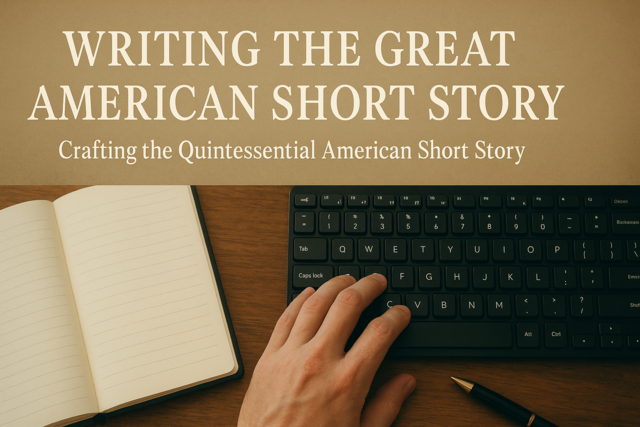Online Class: Novel Writing 101

no certificate
with CEU Certificate*
-
26Lessons
-
46Exams &
Assignments -
6,016Students
have taken this course -
22Hours
average time -
2.2CEUs
Course Description
Mastering the Art of Novel Writing: A Comprehensive Guide
Crafting a novel is an art that intertwines creativity, discipline, and dedication. While the journey of novel-writing can be intricate, it is by no means unattainable, especially when armed with the right tools and guidance.
This course, "Mastering the Art of Novel Writing," offers both budding and seasoned writers a structured path to breathe life into their stories. We delve deep into the nuances of crafting a compelling narrative, providing you with a toolkit to develop engaging characters, build gripping plots, and lace your narrative with your unique style.
Why This Course?
For many, the idea of a structural approach to writing may seem restrictive. However, a well-constructed framework can act as a compass, guiding writers through the vast ocean of their imagination without getting lost. By adhering to tried-and-true methodologies, writers can channel their energy on ideation, weaving intricate plot twists, and creating memorable characters.
Our course encompasses all elements vital to novel creation, referred to as 'dramatic construction'. From the seed of an idea to the final full stop, we support you in your journey, ensuring that your story stands tall on these foundational pillars.
Furthermore, with the ever-evolving publishing landscape, simply penning a great story isn't enough. We extend our guidance beyond writing, offering insights into navigating the complex world of publishing, ensuring your masterpiece finds its rightful place on bookshelves.
A Glimpse into the Course Modules:
-
Definition of a Novel: Understanding the essence of a novel and how it differentiates from other forms of literature.
-
Work Philosophy: Adopting the right mindset and work ethic for sustained writing.
-
Novel Writing Methods: Exploring varied approaches to novel writing to find what suits you best.
-
Selecting a Specific Class & Genre: Recognizing where your story fits in the literary world and tailoring it to a target audience.
-
Point of View (POV): Delving into narrative styles and discerning which lends best to your story.
-
Manuscript Formatting: Preparing your manuscript professionally for submissions.
-
Storyboarding to Synopsis Formation: Structuring your novel, mapping out key events, and preparing a gripping synopsis.
-
Five Elements of Fiction Writing: Unraveling the elements that make fiction resonate with readers.
-
Character to Plot Development: Crafting memorable characters and placing them in riveting scenarios.
-
Setting, Theme, Style, & Tone: Building the world of your novel and defining its mood.
-
Climax, Critical Scenes & Cause and Effect: Driving your story towards pivotal moments and understanding their ripple effects.
-
Dialogue & Exposition: Mastering the art of authentic dialogue and balanced exposition.
-
Polishing of Prose: Refining your narrative for a smooth reading experience.
-
Checklist of Questions: A reflective module ensuring all boxes are ticked before proceeding.
-
Publish or Perish - Getting Ready to Submit: Preparing your work and yourself for the world of publishing.
... and more!
Each lesson is meticulously crafted, complete with assignments, resources, and evaluations to ensure not just theoretical knowledge but practical application.
In Conclusion
Novel writing can be a challenging endeavor, but with commitment, passion, and the right guidance, the path becomes clearer and the journey enjoyable. If you're ready to commit to your literary aspirations, to mold your ideas into coherent, compelling narratives, then this course is your compass, guiding light, and mentor.
Join us on this transformative journey, and let's together bring your novel to life.
- Completely Online
- Self-Paced
- Printable Lessons
- Full HD Video

- 6 Months to Complete
- 24/7 Availability
- Start Anytime
- PC & Mac Compatible
- Android & iOS Friendly
- Accredited CEUs

Course Lessons
Lesson 1. Novel Writing Unplugged
The enduring bond between writer and reader thrives on trust and imagination, as novels serve as conduits for exploring unseen realms and embracing the unknown. Beyond the ambition of commercial success lies the intrinsic reward of storytelling itself—each novel a beacon for connection and reflection, bridging communities with shared narratives.Lesson 2. Guided Literary Marathon: Crafting Novels with Discipline
While embarking on the ambitious journey of writing a novel, authors can benefit from structured routines and strategic time management to maintain rhythm and creativity in their prose. Established authors' experiences demonstrate the power of personalized writing schedules, revealing diverse methods to sustain focus and nurture creativity.Lesson 3. From Concept to Manuscript: The Journey of Novel Crafting
The evolution from initial drafts to polished manuscripts underlines the importance of feedback and revision in writing, as famously noted by Hemingway. Authors' practices of gathering diverse perspectives transform initial concepts into sophisticated novels, echoing Harper Lee's development journey with 'To Kill a Mockingbird.'Lesson 4. Beyond the Pages: Understanding the Art and Evolution of Storytelling Forms
Crafting short stories demands precision, economy, and focus, often challenging even established writers to distill complex themes into concise narratives. In contrast, novels provide the luxury to explore vast worlds, intricate plots, and deep character development over extended narratives.Lesson 5. Genre: The Storytelling Compass
Choosing a genre is pivotal in novel writing as it frames the story's narrative structure and aligns with literary norms, letting your creativity thrive. Reflecting on story nature, writing style, and available time helps in strategically navigating through multifaceted genres.Lesson 6. Narrative Perspectives: A Comprehensive Guide for Novelists
Point of view not only determines narrative delivery but also deeply influences reader engagement and empathy. In modern storytelling, diverse POVs can mark a profound shift towards inclusivity and broadened cultural narratives.Lesson 7. Mastering the Art of Manuscript Formatting
Crafting a novel is like navigating a voyage, where mastering manuscript formatting acts as your compass to success. Adhering to industry standards enhances professionalism, ensuring creative brilliance isn't overshadowed by errors.Lesson 8. The Art of Storyboarding: Crafting Novel Narratives
Storyboarding in novel writing serves as a strategic framework that transforms abstract ideas into a coherent narrative through a visual and structured layout. By organizing scenes and plot points, it enhances creativity, maintains story coherence, and ensures a seamless reader experience.Lesson 9. A Fun Journey into Synopsis Writing
Your synopsis should serve as both a thrilling overview and an emotional map of your story, sketching character arcs and conflicts that offer a glimpse into the transformative journey within. An engaging hook, clear character descriptions, conflict introduction, and hints at resolution are crucial to crafting an effective narrative snapshot.Lesson 10. Fiction Writing: A Journey Through Storytelling
In fiction writing, characters become multidimensional entities reflecting human complexity, and plots serve as the canvas on which their stories unfold. Powerful settings create the backdrop for narratives, while themes and style imbue them with underlying meaning and unique voices.Lesson 11. Character Development Mastery: Unleashing Narrative Potential
Mastering character development involves crafting characters imbued with personal backgrounds and realistic internal conflicts, which drive emotional connections with readers. Through transformative arcs, these characters grow by overcoming their challenges, offering profound insights into the human condition.Lesson 12. The Mechanics of Conflict and Plot in Storytelling
The lesson explores the intricate dance of storytelling, emphasizing how conflict fuels the plot and engages readers. It provides insights into various types of conflict, from battles against nature to internal struggles, and highlights their role in delivering suspense and resolution in a narrative.Lesson 13. Crafting Narratives: Mastering Plot Structures
A well-developed plot drives stories and resonates with readers by intertwining dynamic characters and universal themes. Authors use conflict and suspense to propel narratives, making them emotionally impactful and thought-provoking.Lesson 14. Setting and Theme: The Narrative Framework of Novels
Crafting a novel involves blending characters, plot, setting, and theme to create an engaging narrative tapestry. The setting provides a vivid backdrop that immerses readers, while themes reveal the core truths of the story.Lesson 15. Style vs. Tone: Literary Building Blocks
Style and tone are the artistic tools that bring literature to life, infusing stories with memorable, emotional depth and delivering varied reader experiences. Through careful use of language, authors like Hemingway and Dickens craft unique worlds where style manifests in the structure and narrative voice, while tone shapes the emotional backdrop, from Orwell's bleakness to Austen's irony.Lesson 16. The Pivotal Art of Novel Writing
A well-constructed climax is the narrative pinnacle, transforming readers' understanding and leaving a lasting impact. It must be carefully timed to allow for a reflective denouement, ensuring the finale has room to explore the consequences and deeper meanings of the climax.Lesson 17. The Vital Role of Critical Scenes in Storytelling
Relational dynamics fuel critical scenes, revealing the profound complexities of human connections. These moments illuminate characters’ internal and external conflicts, driving narrative tension.Lesson 18. Mastering Cause and Effect: A Novelist's Guide to Compelling Storytelling
The deliberate use of cause-and-effect relationships helps writers construct multidimensional plots where characters' decisions and actions shape their destinies. By unraveling these links, authors weave narratives that not only entertain but also offer profound commentary on societal structures and universal truths.Lesson 19. Words that Speak: Mastering Dialogue in Writing
Effective dialogue resonates with truth, balancing character revelation and plot progression while maintaining narrative momentum. By observing real conversations and employing deft editing, writers can create dialogue that feels both realistic and compelling.Lesson 20. The Intricacy and Impact of Figurative Language
Seasoned authors like Charles Dickens exemplify how imagery transforms settings into unforgettable canvases, blending literal descriptions with figurative depth. His mastery shows that effective storytelling goes beyond the surface, compelling readers to feel and see within their minds.Lesson 21. Craft Your Narrative with Elegance and Precision
Audience consideration is vital in novel writing, as thematic elements and language should align with reader preferences for genuine engagement. Understanding audience demographics aids in crafting stories that resonate on a personal and emotional level.Lesson 22. Conclusion Mastery: Tying Up the Narrative Tapestry
Crafting an effective conclusion involves skillfully addressing and resolving narrative threads, avoiding new distractions, and maintaining rhythm to ensure reader satisfaction. By mirroring the story's introduction, the conclusion creates a cohesive and memorable end.Lesson 23. From Draft to Masterpiece: The Art of Manuscript Revision
Embracing the chaotic freedom of initial writing allows a writer's creativity to flourish, unencumbered by self-editing. The challenge lies in returning to the text with a critical eye to refine and perfect the manuscript, ensuring it meets the discerning standards of potential publishers.Lesson 24. Enhancing Clarity and Coherency in Writing
Clarity and conciseness are essential in creative writing to keep readers engaged and focused. A consistent writing style helps maintain the narrative's flow, while seamless transitions guide the reader through the story's journey.Lesson 25. Publishing Unlocked
In the dynamic realm of publishing, authors face the choice of traditional pathways, with the expertise of literary agents, or the freedom of self-publishing. Each route presents unique benefits and challenges that, when understood, can lead to successful book launches and thriving writing careers.Lesson 26. Writing Beyond Completion: A Pathway to Continuous Creativity
Great novels blend enlightenment and enchantment, sparking our imagination and deepening our understanding of humanity. With the milestone of completing a manuscript behind you, remember the journey of writing is an ongoing cycle of creation and reflection.
Learning Outcomes
- Analyze the role of historical context and diverse philosophies in shaping novel writing as a dynamic and evolving literary form.
- Identify and describe the essential features of a novel, including cohesive plot structure, well-defined characters, and an undercurrent of reality.
- Define a structured writing plan, including outline, synopsis, and chapter summaries, to maintain focus and organization throughout the novel-writing process.
- Identify personal writing schedules and strategies to consistently dedicate time for writing, ensuring steady progress on their novel.
- Demonstrate understanding of diverse novel writing methods by outlining personal approaches to creative and structured storytelling.
- Identify and apply character development techniques to create complex and engaging characters within a narrative.
- Analyze how technological advancements and changing reader preferences impact the landscape of short stories and novels by listing two examples of each influence.
- Define the unique attributes of short stories compared to novels by identifying three key characteristics that contribute to their distinct form and narrative style.
- Identify personal writing preferences and align them with a suitable novel genre by evaluating individual storytelling style and thematic interests.
- Define the characteristics of at least two novel types, such as picaresque and epistolary, with examples from modern literature.
- Demonstrate an understanding of how different points of view can impact reader engagement and emotional depth in storytelling.
- Identify the distinct characteristics and advantages of first-person, third-person limited, third-person omniscient, and second-person points of view in novel writing.
- Define standard manuscript formatting requirements, including font type, margins, and page numbering, by the end of the session.
- Demonstrate mastery of lesson content at levels of 70% or higher.
Additional Course Information

- Document Your Lifelong Learning Achievements
- Earn an Official Certificate Documenting Course Hours and CEUs
- Verify Your Certificate with a Unique Serial Number Online
- View and Share Your Certificate Online or Download/Print as PDF
- Display Your Certificate on Your Resume and Promote Your Achievements Using Social Media

Choose Your Subscription Plan
No Certificate / No CEUs
This course only
| Includes certificate | X |
| Includes CEUs | X |
| Self-paced |

|
| Instructor support |

|
| Time to complete | 6 months |
| No. of courses | 1 course |
Certificate & CEUs
This course only
| Includes certificate |

|
| Includes CEUs |

|
| Self-paced |

|
| Instructor support |

|
| Time to complete | 6 months |
| No. of courses | 1 course |
Certificates & CEUs
Includes all 600+ courses
| Includes certificate |

|
| Includes CEUs |

|
| Self-paced |

|
| Instructor support |

|
| Time to complete | 12 Months |
| No. of courses | 600+ |
Certificates & CEUs
Includes all 600+ courses
| Includes certificate |

|
| Includes CEUs |

|
| Self-paced |

|
| Instructor support |

|
| Time to complete | 24 Months |
| No. of courses | 600+ |
Student Testimonials
- "Great course, challenging quizzes and assignments. The instructor is helpful and provides the right amount of guidance." -- Nicholas Y.
- "The course helped fill in gaps in my knowledge about novels and novel-writing. I feel enabled to start drafting my first novel after completing this course." -- Lisa G.
- "I appreciated the positive feedback from the instructor very much." -- Ronald C.
- "The instructor was very pleasant individual and helpful as well!" -- Laura A.
- "Two thumbs up!" -- Ralph C.
- "Thoroughly enjoyed it." -- Hazel G.
- "I loved this course! Thank you for offering it!" -- Laura G.
- "Instructor was quite good." -- Rick H.
- "The instructor must have been very open-minded to accept different avenues of the imagination and also to accept the "real slice of life" as she put it." -- Mary M.
Related Courses
-
 72 hours
7.2 CEUs
Writing Help Course Bundle
+ More Info
72 hours
7.2 CEUs
Writing Help Course Bundle
+ More Info
-
 19 hours
1.9 CEUs
Creative Writing 101
+ More Info
19 hours
1.9 CEUs
Creative Writing 101
+ More Info
-
 11 hours
1.1 CEUs
Writing Effective Emails in the Workplace
+ More Info
11 hours
1.1 CEUs
Writing Effective Emails in the Workplace
+ More Info
-
 11 hours
1.1 CEUs
How to Write Short Stories for Children
+ More Info
11 hours
1.1 CEUs
How to Write Short Stories for Children
+ More Info
-
 11 hours
1.1 CEUs
Journaling and Memoir Writing
+ More Info
11 hours
1.1 CEUs
Journaling and Memoir Writing
+ More Info
-
 11 hours
1.1 CEUs
How to Write a Short Story
+ More Info
11 hours
1.1 CEUs
How to Write a Short Story
+ More Info
-
 12 hours
1.2 CEUs
Advertising, Marketing and Sales Writing
+ More Info
12 hours
1.2 CEUs
Advertising, Marketing and Sales Writing
+ More Info
-
 9 hours
0.9 CEUs
Nonfiction Writing 101
+ More Info
9 hours
0.9 CEUs
Nonfiction Writing 101
+ More Info
-
 12 hours
1.2 CEUs
How to Write Case Studies
+ More Info
12 hours
1.2 CEUs
How to Write Case Studies
+ More Info
-
 16 hours
1.6 CEUs
Advertising Copywriter
+ More Info
16 hours
1.6 CEUs
Advertising Copywriter
+ More Info
-
 17 hours
1.7 CEUs
Poetry Writing 101
+ More Info
17 hours
1.7 CEUs
Poetry Writing 101
+ More Info
-
 5 hours
0.5 CEUs
Creative Writing for Beginners
+ More Info
5 hours
0.5 CEUs
Creative Writing for Beginners
+ More Info
-
 12 hours
1.2 CEUs
Write to Win: Secrets of Persuasive Writing
+ More Info
12 hours
1.2 CEUs
Write to Win: Secrets of Persuasive Writing
+ More Info
-
 5 hours
0.5 CEUs
Writing the Great American Short Story
+ More Info
5 hours
0.5 CEUs
Writing the Great American Short Story
+ More Info
-
 6 hours
0.6 CEUs
Freelance Writing 101
+ More Info
6 hours
0.6 CEUs
Freelance Writing 101
+ More Info
-
 12 hours
1.2 CEUs
Paranormal Romance Writing
+ More Info
12 hours
1.2 CEUs
Paranormal Romance Writing
+ More Info
-
 14 hours
1.4 CEUs
Journalism 101
+ More Info
14 hours
1.4 CEUs
Journalism 101
+ More Info





